I have used Amazon affiliate links on this page. As an Amazon Associate, I earn a commission from qualifying purchases at no added cost to you. Thank you!
- Common Names: Engineer Goby, Convict Blenny, Convict Goby
- Scientific Name: Pholidichthys leucotaenia
- Origin: IndoPacific, Fiji
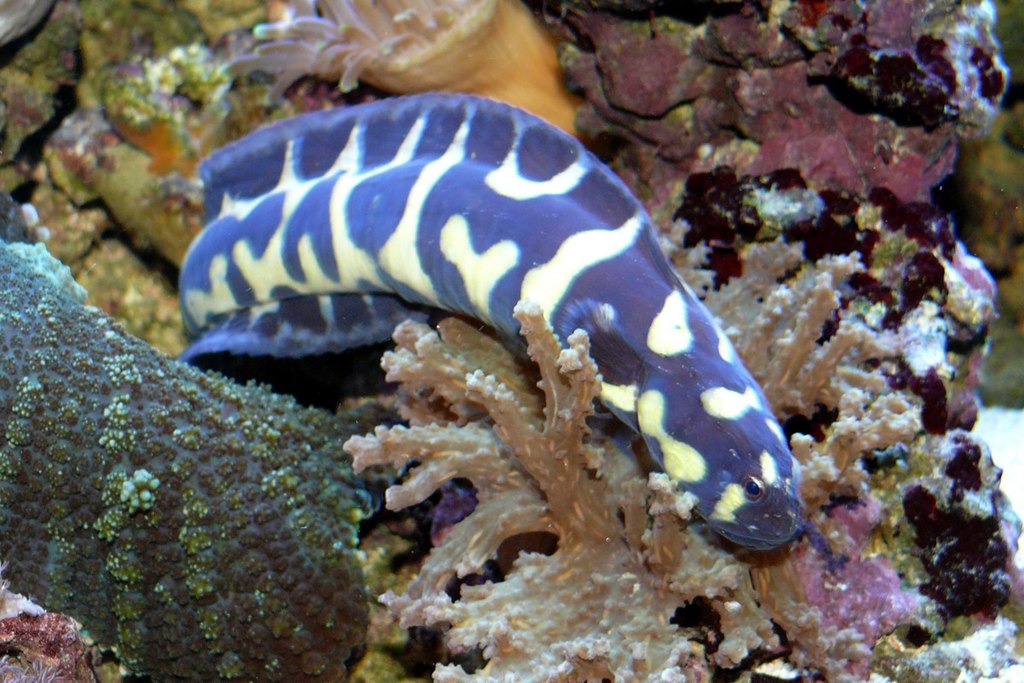
Pholidychtys luecotaenia, the engineer goby, has a black body with a white straight stripe. Convict Goby and Convict Blenny are only a couple of the nicknames given to Engineer Gobies. This complicates the process of recognizing these remarkable species because another fish, Priolepis nocturna, also goes by the moniker Convict Blenny. Additionally, this fish is not a genuine goby. They are incredibly resilient and serene. In an environment with reef tanks, they can be kept alongside other calm fish, but in smaller tanks, they could turn hostile toward different blennies, gobies, or dartfish.
Table of Contents
Why are These Fish Called Engineer Goby?
Engineer goby are somewhat territorial and social, much like cichlids. They didn’t often spit at each other. In the wild, Engineer Goby establish swarms of dozens or even thousands of individuals that collaborate to create lengthy, linked passageways. Engineer Goby get their moniker from their constant construction activities. These fish simply can’t be at ease until there are structures for them to bury themselves under.
Scientific Classification
The west-central Pacific Ocean is home to the marine fish species Pholidichthys leucotaenia. It is not a blenny or a goby, despite its common names; rather, it is one of two species in the Pholidichthyidae family and Genus Pholidichthys. Surprisingly, they are also closely linked to the Cichlidae family, which contains numerous cichlids, Oscar fish, flower horns, many other cichlids, and angelfish.
Natural Habitat of the Engineer Goby
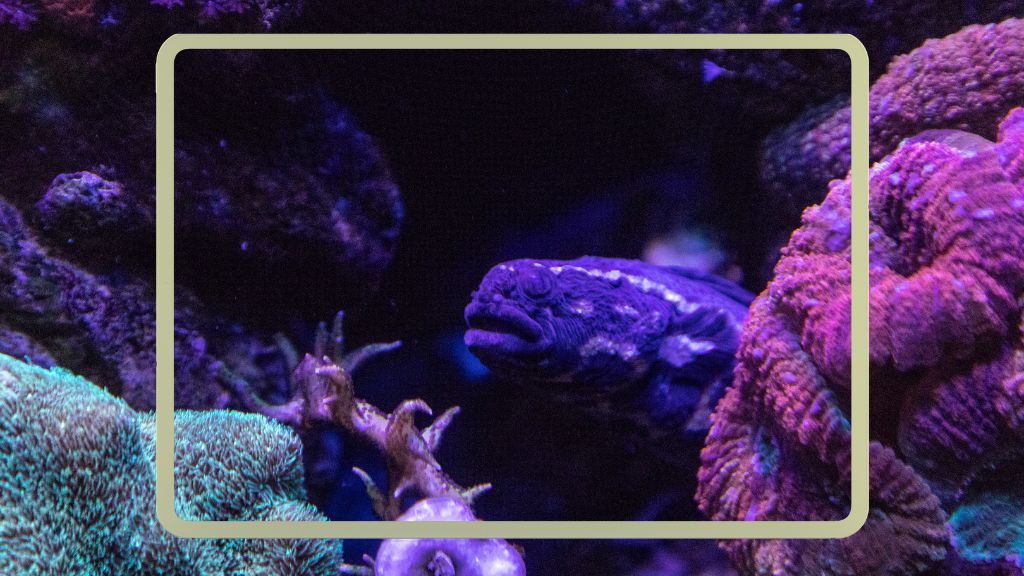
From the Philippines to the Solomon Islands, shallow lagoons and coastal reefs are home to Pholidichthys leucotaenia. Under ledges or near coral heads, it is frequently found in schools. These schools swim together in such close groups that they resemble one cohesive creature. The species is occasionally seen in the aquarium trade, where it is infamous for upsetting all but the most sturdy constructions. As was already indicated in this article, DNA analysis confirms that this species belongs to a different fish family called Pholidichthyidae and is neither a blenny nor a goby.
Under Eugenie Clark’s direction, researchers in the Solomon Islands discovered young fish poking their heads up through cracks in the bottom and nearby coral reefs. These young animals swim up to 50 meters away from their home burrows throughout the day to eat plankton. All of the larval fish returned to their burrows at the end of the day, which was a remarkable and unusual behavior.
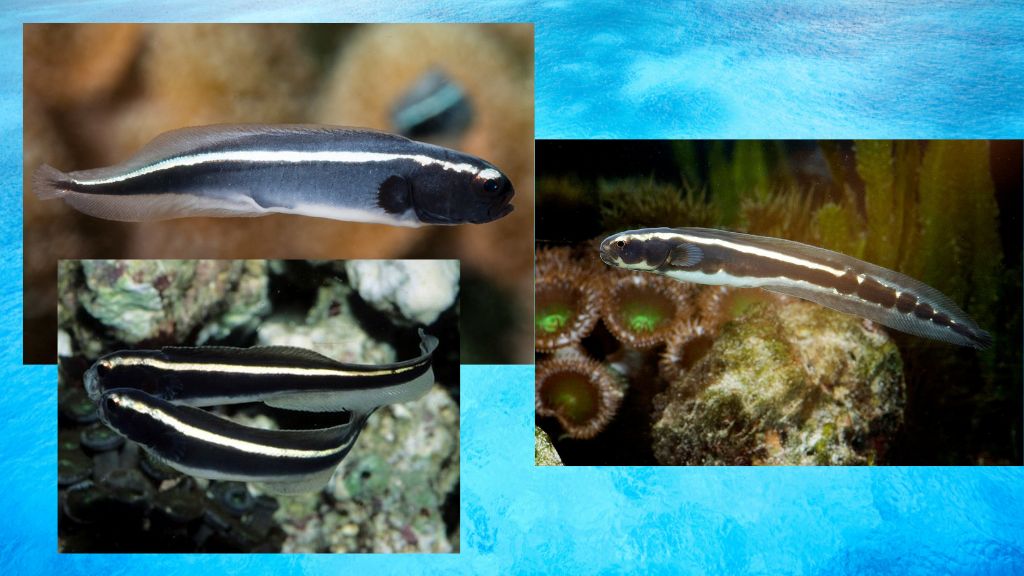
The parents expel debris from the burrows while their young are out foraging. The parents may scoop up and spit out of the hole as much as 3 kilogram (6.6 lb) of sand in a single day. A 6 m-long network of tunnels and chambers have been found through research. Young fish are suspended by their mouths from the tunnel roof at night by flimsy mucus threads.
Common Behavior of Engineer Goby
Gobies who specialize in engineering have an interesting digging habit. They constantly remain concealed in the tunnels they excavated in the sand bed at the bottom of the tank. They tend to be somewhat bashful and spend most of their time digging by themselves.
Convict Goby don’t create a single tunnel that they consider their home and spend the entire day and night in. Instead, they will keep excavating and re-excavating many sets of tunnels at various locations throughout the sand bed.
The majority of the time, you will see them moving in large groups on bait around ledges or in the water to make themselves appear to be a single, large fish rather than a number of small ones.
Transformation From Juveniles to Adults
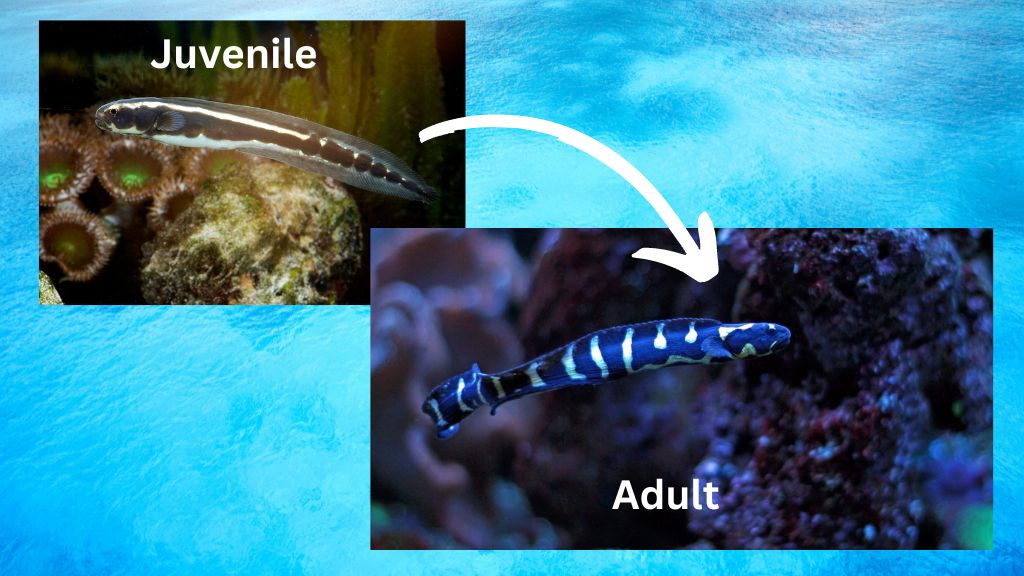
The engineer goby’s appearance changes significantly with age, like many fish do. A young engineer goby has black body with horizontal white bands, which somewhat resembles a real goby. And at this point in their life they resemble the moderately toxic Coral Catfish in appearance (Phetusus angularis). As the fish ages, its horizontal lines become vertical bars, giving it a more eel-like appearance. This new coloration resembles a yellow and black striped pattern on all over the body. And when this happens these fish spend less time swimming exposed themselves.
Over the course of the first year of their existence, they develop this unique coloring pattern. Adults are long, thin, and also have an eel-like shape in addition to having these intriguing stripes or bars. In actuality, your non-fishy pals who observe your fish tank are likely to think that they are eels.
Engineer goby Size and Lifespan
This little fish, which resembles an eel, can have the potential to grow as long as 24 inches or two feet in their natural habitat in the oceans as some researchers have claimed. And when that happens they can be about 11 years old, but it is quite exceptional. Because, in an aquarium setting they barely go beyond 12 inches.
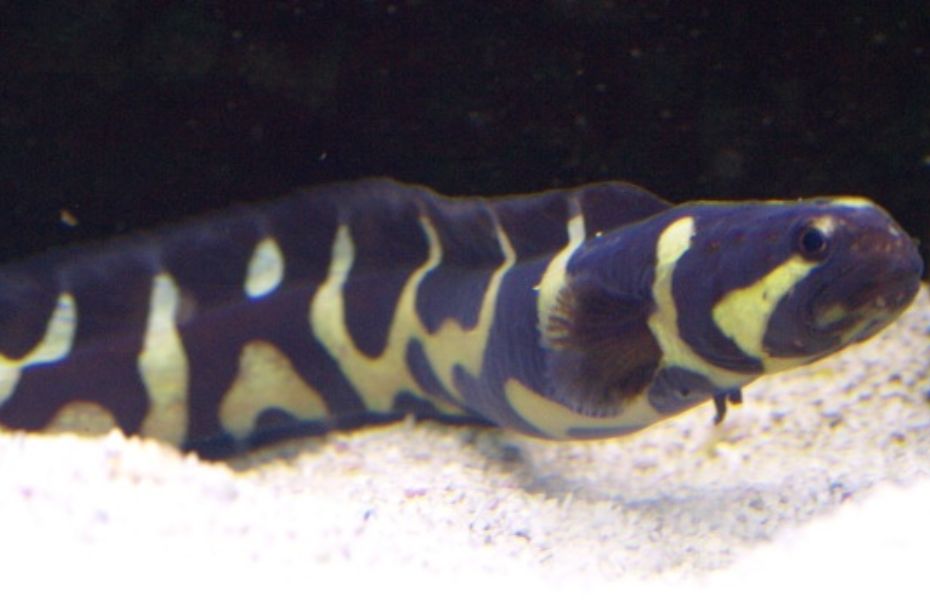
Engineer Goby Tank Size
For adults, a 55-gallon tank is the absolute minimum. Young Engineer Goby (2–3 inches) can be kept in 20–plus gallon storage tanks until they reach adulthood. Larger water amounts are suggested because these animals are predators with a methodical eating style.
A single overfeeding incident can result in drastic variations in ammonia and nitrite, and smaller tanks change in specifications very quickly.
Note:-
The Engineer Goby, like many other fish with eel-like shapes, may constantly attempt to escape from an aquarium. This may occur particularly when they sense a threat from the other fish or the tank environment, as well as from cramped conditions and stress. This can occur more frequently, especially at juvenile stage and when swimming freely at night. Therefore, it’s crucial to patch any holes or loosened tank covers that these fish could use to escape the tank and potentially perish in the process.
Tip: A Wavemaker is a good addition to simulate a marine habitat!
Engineer Goby & Reef Tank (Are engineer goby reef safe?)
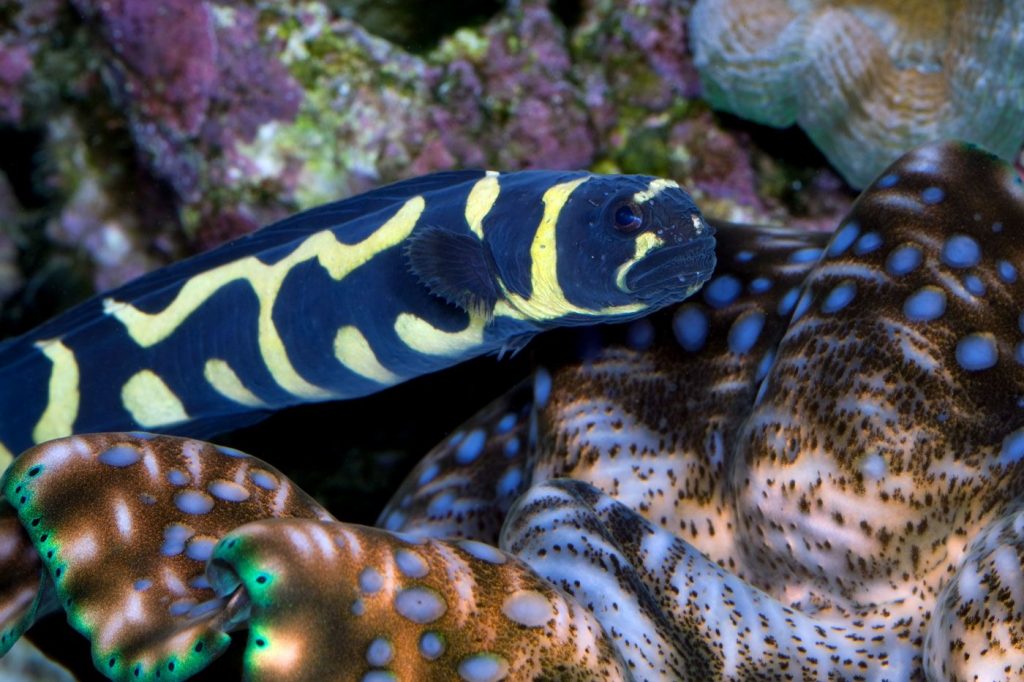
Engineer goby fishes continually wander around digging in the sand, as was previously indicated. The reef and the rock below may sink due to this continual movement. There is a good danger that your structure may collapse and tumble if the rink drops too low.
Therefore, you must ensure that your reef is set up on a glass bottom. Instead of laying the foundation on top of the sand, choose the structure that is the lowest. By doing this, even if the gobies dig behind the rocks, you will still be able to protect your rock tower building.
Substrate Requirements
Engineer gobies spend the majority of their time digging, so the tank bottom needs to be treated with extra attention. To provide them the most comfort, fill it with a deep sand bed or a living sand substrate.
They dig their tunnels in the sand most of the time, although they can also use small pieces of debris. Even though they spend the majority of the time hidden within, as soon as they sense that it is time for their meal, they will immediately jump out of their burrows and seize the food.
Optimal Water Conditions & Engineer Goby Care
One of the even more beginner-friendly marine fish is the engineer goby. They are resilient fish that can adjust to shifting aquatic environments. However, the ideal water conditions that you can provide for their wellbeing, ideal growth, and optimum life span are still mentioned below.
Given that their natural habitat is in equatorial island groups like Indonesia, temperature levels must be a touch high; be careful to keep them between 75 and 82°F. It’s important to know that Engineer Goby aren’t particularly sensitive to slight variations in these levels because a good aquarist strives to keep ammonia, nitrite, and nitrate as close to 0ppm as possible.
The salinity level must be in-between 1.020-1.025 and P.H level should be in-between 8-8.4, hence slightly alkaline
Specific Gravity of the water should be 020 to 1.025.
Diet of Engineering Goby
It is quite simple to feed the Engineer Goby. Despite being carnivores, they don’t need live prey. In fact, it’s best to avoid giving them live food because they are so slow and ineffective at capturing it.
Instead, you can mix prepared foods with fresh or frozen carnivorous treats to feed your Engineer Gobies. As flakes drift slowly and are likely to be snatched up by the other fish, a sinking carnivore pellet ensures that the Engineer Goby will have its fair share.
Given that this fish is a carnivore by nature, it should be fed premium heavy meals such live black worms, mysis shrimp, artemia (brine shrimp), or other weighty fish and shellfish.
Due to their cautious nature, these fish will undoubtedly emerge from their burrows during feeding time to grab the tasty food scraps that are drifting past in the water column.
It is advised to feed them twice daily. The Fluvial Bug Bites are an another excellent option.
Temperament & Tank mates
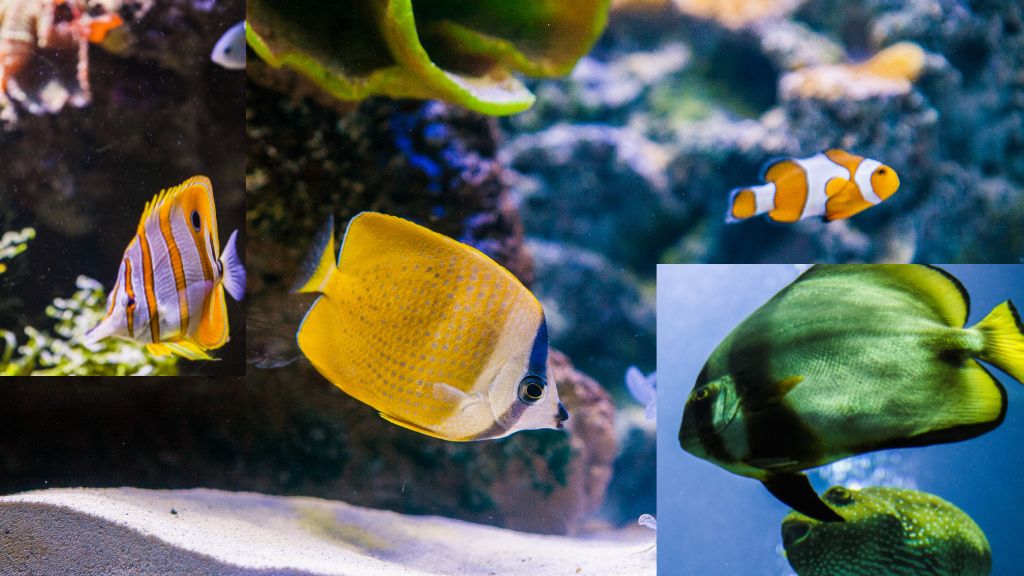
Engineering Goby are generally quiet, friendly, and never exhibit any aggressive behavior toward other aquatic animals in the aquarium. However, given that they often eat meat, it is unrealistic to expect them to spare the smaller fish in the aquarium, even when they are starving.
The Engineer Goby should therefore be given ample food; otherwise, they will inevitably try to kill and eat their smaller tankmates.
However, they will harm anything that is little and moving slowly enough to be consumed. Small, slender fish are therefore vulnerable to becoming dinner, including Firefish (Nemateleotris sp.), smaller Gobies, and immature Blennies.
Smaller saltwater shrimp are also at risk of consumption. However, adults of the larger species, such as Banded Coral Shrimp (Stenopus hispidus) and other large crustaceans like Arrowhead Crabs, are not harmed by the Engineering Goby.
Any fish that is too big to be easily consumed would make a good tank companion. This comprises fish from the conventional aquatic fish community, such as damselfish, clownfish, angelfish, tangs, and dwarf lionfish. But avoid putting engineer goby in same aquariums with aggressive cave dwelling eels like moray eels as they will eventually be found and eaten.
Diseases
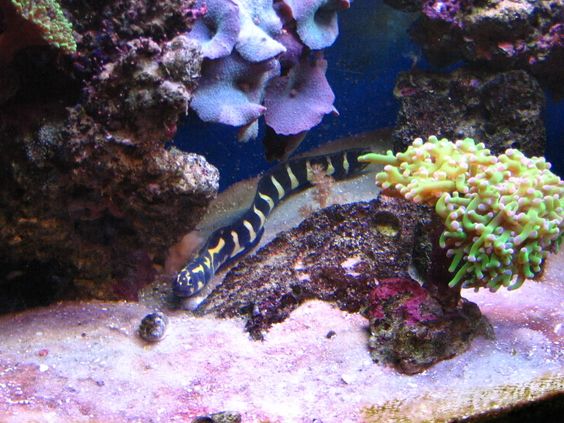
These fish are somewhat susceptible to the effects of saltwater Ich.
However, they avoid the lifecycle’s hatching stage since they spend almost all of their time in the sand bed.
Special Cautions Should Be Taken for Scale less Engineer Goby

The aquarium must be kept free of high levels of germs and fungi. The Engineer Goby is a digger-like fish with no scales.
Fish without hard scales are not protected in the same way the fish with scales. Therefore any potential wound are highly prone to contracting an infection whether they are bacteria, virus or fungal.
For an example an Engineer Goby can easily get scratched by a coral frag, or during a conflict with another tankmate. And if inadequate standards resulted in the water having higher-than-normal amounts of bacteria, fungi, viruses, etc. Infections are probably on the horizon for this fish. So as these fish are very much hardy and not so sensitive to water conditions it’s important to remember that the aquarium should be kept clean and filtered properly. This reduces the chances of them getting infected.
Additionally, scaleless fish are very aware of drug dosages. Normally, the uptake of medications is slowed by fish scales. Therefore, it’s vital to use 1/2 of the standard dosage for treating scaleless fish like engineering goby as a general guideline.
The aquarist needs even longer time than usual to treat the ailment in many situations where even a 1/2 dosage may not be sufficient to treat the infections. Taking into account all of this, handling a sick Engineer Goby is strongly advised using a quarantine tank.
Engineer Goby Breeding in Captivity
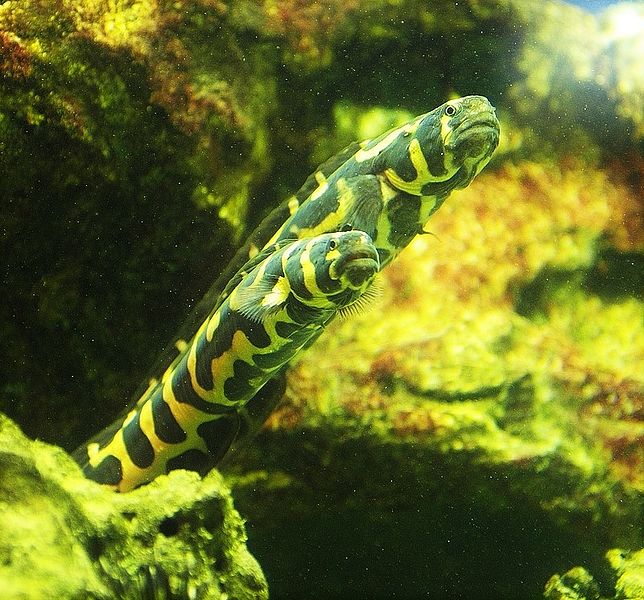
Because these fish are large, sociable, and the sexes are visually identical, reproduction in home aquariums is still quite uncommon. Males and females cannot be distinguished from one another visually. The Engineer Gobies are able to tell in a way that we cannot.
You must provide them a similar dynamic where the Gobies have a wide selection of partners to pick from since they live in big colonies as adults. This entails providing at least 4-6 Engineer Gobies with ample room to establish a colony.
You’ll probably never know when the actual event takes place because Engineer Gobies spawn inside of their tunnels. Fish can be trained by giving them frequent, substantial feedings of premium meaty food. However, sexual maturity, compatibility, and opportunity are the only known environmental factors that cause spawning.
When the eggs hatch, you’ll be able to see dozens to hundreds of young animals swimming freely close to the burrow entrance. They will quickly retreat to the safety of the lair at the first indication of danger. You can leave the parents to raise the young unless the other fish in the aquarium endanger them.
Baby Engineer Gobies will immediately consume copepods and other zooplankton together with live or frozen brine shrimp nauplii. Just keep feeding them until they are big enough to take little flakes and pellets. You can now start looking for them a new home at your neighborhood fish market!
Engineer Goby Growth Rate
The engineer goby fry will gradually change color over the course of the first year as it grows up to 1 cm per month. They can then be released into a new tank once they start to resemble their parents much more. They will become hostile if released with other gobies, especially other Engineer Gobies.
Conclusion
One of the best saltwater fish for beginners is the engineer goby. They rapidly become acquainted with their tank mates and begin looking for a place to call home in the sand.
The fish puzzles the audience owing to its similar personality to other fishes and looks attractive and alluring with its color formations throughout their growth stages and each day in accordance with the day-night cycle.
In the aquarium trade, they are not very expensive, and one can easily acquire them as a single fish or a school of them. You can begin maintaining this amazing, incessantly busy, and shy fish if there is a communal tank that is at least 40 gallons in size or a separate 20-gallon tank for a set, a deep sand bed.
Pingback: Tessalata Eel: Unleashing the Mystery - Pet Fish 101